#semi integrated models
Explore tagged Tumblr posts
Text
"In a degraded and semi-arid farming area in India, simple science-driven changes to the landscape have colored the horizon, and a village’s fortunes, with green.
In the Latur district in the central western state of Maharashtra, 40 years of erratic rainfall, groundwater depletion, soil erosion, and crop failures have impoverished the local people.
In the village of Matephal, the International Crops Research Institute for the Semi-Arid Tropics (ICRISAT) launched a project in 2023 that aimed at addressing these challenges through integrated landscape management and climate-smart farming practices. [Note: Meaning they've achieved this much in just two years!]
Multiple forms of data collection allowed ICRISAT to target precise strategies for each challenge facing the 2,000 or so people in Matephal.

Key interventions focused on three critical areas: water conservation, land enhancement with crop diversification, and soil health improvement. Rainwater harvesting structures recharged groundwater around 1,200 acres, raising water tables by 12 feet and securing reliable irrigation. Farm ponds provided supplemental irrigation, while embanking across 320 acres reduced soil erosion.
Farmers diversified their crops, converting 120 or so acres of previously fallow land into productive farmland with legumes, millets, and vegetables. Horticulture-linked markets for fruits and flowers improved income stability.
Weather monitoring equipment was also installed that actively informed sustainable irrigation practices.
“It is a prime example of how data-driven approaches can address complex agricultural challenges, ensuring interventions are precise and impactful. Matephal village is a model for other semi-arid regions in India and beyond,” said Dr. Stanford Blade, Director General-Interim at ICRISAT.
Farmers actively participated in planning and decision-making, fostering long-term commitment.
“This ICRISAT project improved yields, diversified crops, and boosted incomes. It also spared women from walking over a kilometer for drinking water, now available in the village for people and animals,” said Mr. Govind Hinge of Matephal village.
Looking ahead, ICRISAT writes it wants to use Matephal as a case study to scale these methods across India’s vast and drier average. As Matephal’s fields flourish, the village is a testament to the power of collaboration and science in transforming lives and landscapes."
youtube
-Article via Good News Network, March 3, 2025. Video via International Crops Research Institute for the Semi-Arid Tropics (ICRISAT), February 26, 2025
#india#tropics#maharashtra#farming#agriculture#sustainable agriculture#water scarcity#drought#farmers#good news#hope#Youtube#video#climate crisis#climate action#climate resilience
732 notes
·
View notes
Text
An explanation of the Theory of Structural Dissociation
This post, originally, was attached to a syscourse argument. I realized that it might be nice to have a version that can be reblogged without any syscourse or ugliness behind it. This post has no DNI, it's meant to be educational, and if it helped you, maybe consider giving it a share.
The ToSD is a very scary, highly misunderstood monster to the system community. When you think you understand it-- Stop. Because you don't.
This post, though, might be an okay place to start learning about it. I hope it helps others understand some ToSD basics.
[Some ToSD facts to know before reading]
The ToSD
The ToSD was actually started in the late 1800s by Pierre Janet. Many, many other doctors have worked on and contributed to the theory over the last century. This was the competing theory against Freud's work, happening within years of each other. If Freud hadn't been such a dramatic pervert, Janet's work might be more well-known.
It is what it is, though.
If you've heard of the ToSD, though, you probably know it from The Haunted Self.
This (now) infamous book was written by three people. One of which lost his license for abusing his patient.
Many people think The Haunted Self is the ToSD. That this is the book that started it.
These two facts have been used in the recent past to discredit the theory.
Let's talk about it.
The Haunted Self came out at a time that allowed it to really gain traction based on technology. Being able to SEE it happening on brain scans was mind-blowing, and the proof for the theory continues to grow.
Opposition to the ToSD is based on atrogenic and sociocognitive models (fantasy, no plurality is real). It really is the best model we have and one that continues to consistently hold true. So... to explain the ToSD in very a semi-simple way...
The theory states that everyone is born with an unintegrated sense of self. Children have action systems, and these are the base building blocks of who we become. These are things like energy management, attachment, caretaking, survival (ex. hunger and thirst), and many more. From these, we build responses to our environment and people around us. When looked at from afar, or as a larger picture, these action systems can be said to, "exist for their own sake", which is where the confusion stems from.
For example, a child screams for food because he's hungry, and that action system has been activated. Once activated, it becomes the primary concern, but it is still the same child. This sense of hunger and how to deal with it is integrated into the sense of self (unless you're like me and a lot of your trauma is around food, and then a division occurs, and you refuse to care for that part of yourself or reject it entirely), and slowly begins to interact with other action systems, with no delay or divisions.
For example, you learn to balance your hunger and bathing needs, prioritizing and compromising needs/wants without issue.
Typically, as we get older and develop, we build on these base states and have easy access to them at all times. They interact in a healthy, cohesive way that makes you, you.
In structural dissociation, these parts become divided due to interruption, losing access to other action systems, and they begin to build within themselves.
The amount of integration before disruption (basically age) can help explain why there are levels and why some people develop PTSD vs OSDD vs BPD vs DID. For example trauma at age 4 will likely result in DID and a lot more amnesia because there was so little integration to begin with-- the walls are built higher, before any part had a chance to meet the others (this doesn't take into account predisposition to dissociate-- this is why some children in similar situations develop a CDD and some don't-- some people are not physically capable of dissociating like that).
Trauma at 9 could result in OSDD, as parts have already had a chance to start working together. Like, you met your neighbor before the fence was built. You still know them. This level of integration can't go TOO far backwards. Once the sense of self has come together without interruption, or once those formative years pass, you can't make those same changes to the brain. Someone who's 25 and becomes traumatized won't see the same level of damage to certain brain areas as someone with early life traumatization, and they won't have developed similar neural pathways that lead to the disordered behavior.
From action systems, we get into defense responses. In structural dissociation, these responses tend to fall on the EPs-- parts that are still stuck in trauma. Emotional reactions and triggers are so far divided that they can activate unchecked, and with volatility. A big misconception is that ANPs won't know about trauma, but that's not necessarily true. Dissociation as a mechanism, on all levels of structural dissociation, is meant to detach feelings from memories, so I remember a lot of trauma but have no emotional connection to that trauma. The "not me" part of dissociation. And this happens in PTSD and DID and everything in-between.
The difference is how much autonomy that part has. In DID, that part is so far separated that it's essentially its own person (l don't want to get into parts language or "less than" conversations in this post, this is just about developing autonomy). In PTSD, these parts are still connected, so the "main", or whatever word you want to use, still accepts that the experience is their own and can integrate it into their sense of self. For example, you learn not to go down those dark alleys, but know that the rest of the world is safe. You change a few habits, become a little more cautious, and maybe the memory fades, maybe it doesn't, but you're still you.
And this can be because of age (someone was already highly integrated) or because of duration (ongoing repeated traumas, with little sense of reprieve, end up with higher walls and more division-- one time use vs longtime use).
In this way, the longer the duration, the more parts are created, and you end up with multiple EPs and ANPS (secondary and tertiary SD). Keep in mind that there have been updates to the ToSD that show there are more than just the two types of parts, and that functions very often overlap.
And that's the basics.
#not syscourse#ToSD#syscourse neutral#system safe#pro endo#theory of structural dissociation#did#osdd#CDD#debunk#research#actually traumagenic#actually dissociative
62 notes
·
View notes
Text
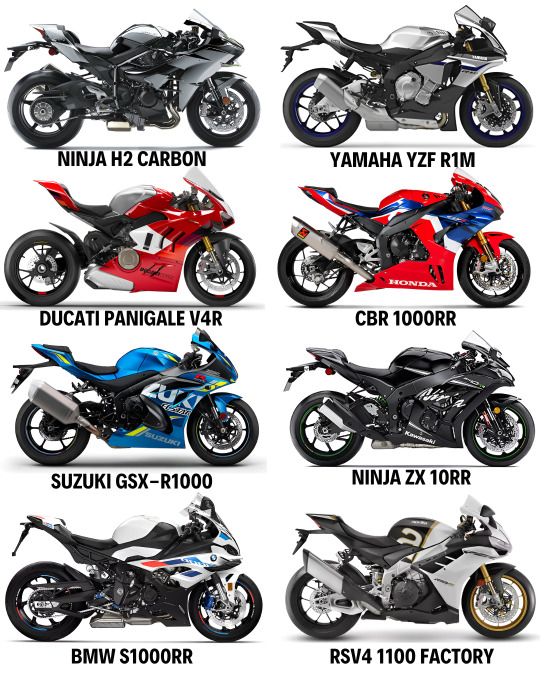
Top Super Bikes
These motorcycles represent some of the most advanced and high-performance superbikes in the world, designed for speed, precision, and cutting-edge technology. Here's an overview:
1. Yamaha YZF-R1M:
An elite version of the Yamaha R1, the YZF-R1M is a track-focused superbike featuring advanced electronics, Öhlins semi-active suspension, and lightweight carbon fiber bodywork. Its cross-plane crankshaft engine delivers exceptional torque and a unique sound.
2. Ducati Panigale V4 R:
A masterpiece of Italian engineering, the V4 R is Ducati's homologation special for racing. It features a 998cc Desmosedici Stradale R engine, winglets for aerodynamic stability, and top-tier electronics like traction control and wheelie control.
3. Honda CBR1000RR-R Fireblade:
Honda's flagship superbike, this model emphasizes precision and control. Equipped with a high-revving inline-four engine and advanced aerodynamics, it's a favorite among racers and enthusiasts.
4. Suzuki GSX-R1000R:
The GSX-R1000R is Suzuki’s pinnacle sportbike, combining the brand's legendary "Gixxer" heritage with modern tech like a bi-directional quick shifter, ride modes, and adjustable suspension.
5. BMW S1000RR:
Known for its shark-like design and power, the S1000RR boasts a ShiftCam engine for variable valve timing, integrated electronics, and razor-sharp handling.
6. Kawasaki Ninja ZX-10RR:
A race-homologated version of the ZX-10R, the ZX-10RR has a lightweight design, forged pistons, and a screaming inline-four engine tuned for racetrack domination.
7. Aprilia RSV4 1100 Factory:
This Italian superbike blends a 1078cc V4 engine with MotoGP-derived aerodynamics and semi-active suspension, delivering exceptional agility and power.
8. Kawasaki Ninja H2 Carbon:
A street-legal supercharged beast, the H2 Carbon combines jaw-dropping power with carbon-fiber bodywork and advanced electronics, setting it apart as an engineering marvel.
#bikes#electric bikes#motorcycle#triumph#moto#kawasaki#yamaha#ducati#suzuki#bmw#bmw motorsport#superbikes#automobile#automotive
14 notes
·
View notes
Note
I'm thinking of getting one of those robot vacuums, but don't know how to start picking the right one. Do you have opinions on the matter? Do you like yours, and if so, what model is it?
I have a Xiaomi S10 EU, which is a midrange model that I think is now discontinued in favour of the S20? Xiaomi does a pretty good job with their designs, my family have various Xiaomi models that all work fine. Roborock is another brand I've heard good things about, and they're an offshoot of Xiaomi and seem to be where a lot of design innovation is so presumably that's a good sign. I assume iRobot is still making Roombas but I've never used a Roomba.
(The craziest new stuff from Roborock includes a robot arm for picking up and moving small objects out of the way? Crazy, you can now teach stabby to thrust!)
A few notes
1) They work best if you can keep your floor clear and generally free of small objects, and obviously don't navigate stairs and steps well. My apartment has very little stuff on the floor, and all my cables and wires are tucked into corners and along skirtings. If your wife has filled your house with chintz you may have a hard time getting a robot around on the floor.
Robovacs love to eat bag straps and shoelaces and charging cords, so if you tend to have those laying around on the floor and don't have the wherewithal to clear them up, you'll probably spend a lot of time untangling things from the brush.
2) They can handle most area rugs, but not all, e.g. it handles my thin cotton living room rug with short tassels without an issue but I have to move my thick kitchen floor mat out of the way or it'll eat the longer, thicker tassels. You can mark areas as no-vacuum zones if this isn't your bag.
3) Definitely spring for one with at least LiDAR, which you can see by the little stick-up lighthouse module on the top that houses the LiDAR module. Without LiDAR the robot has to just bump around semi-randomly to navigate, which is slow and inaccurate. It can build a map but the map is very poor and it barely knows where it is.
With LiDAR it knows exactly where it is, because it knows where it isn't. The very newest and most expensive bots do away with rotary LiDAR and just use forward looking cameras and 3D depth sensors to do VSLAM but if you're going for that price range from a big manufacturer you'll probably be fine. Most companies list their sensors on their site, but they often use weird names so it can be hard to tell.
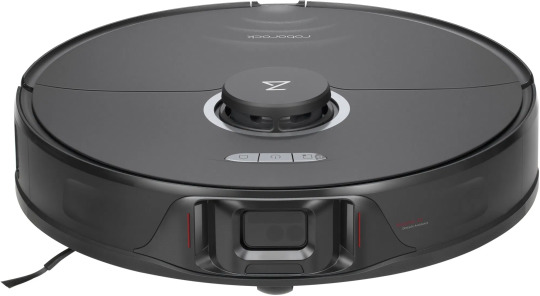

(see above, with and without a LiDAR tower. Some very new models can retract the LiDAR tower to go under low furniture.)
4) You can cover a lot of house without needing the self-emptying base stations even if you run it regularly, I'd say probably around 200m² in a fairly ordinary dust environment. In my 50m² apartment I run it at least every weekday and empty out the integrated dust container once a week and that's usually fine, and I don't have any particular air filtration running, but I do keep the windows mostly closed when I can.
5) Speaking of maintenance, I don't use the mop feature on mine but it does keep your floors cleaner while requiring more attention to be paid to water levels. I'm actually going to try using mine more now and see how that goes. This is one thing where I think the stations might make sense even for a pretty small apartment. My brother uses the mop feature on his all the time and he likes it.
6) General maintenance: not that much! It'll buzz you on your phone when it thinks a component has hit end of life but so far I don't think anyone is using DRM to force you to use first-party parts or making you throw away things that are working, you can just manually reset the timers, although so far when the warnings do come up I tend to agree that it's time to replace a part.
You have to empty out the dust and change the water, and if it eats something you might spend a few minutes detangling the rotating brushes. The brushes will get knotted with hair and need cleaning every couple weeks to months depending on how much hair and how long it is, but most models come with a little knife tool for cutting the hair. Never tried the models that advertise that they don't get tangled.
7) Bonus nerd shit you probably shouldn't do. If you really do not want your Robovac connecting to the cloud, there's some work on developing self-hosted management servers that you can point a rooted robot at, and of course you can root your vacuum cleaner, because it's just an embedded Linux box on wheels. The open source management server software is called Valetudo.
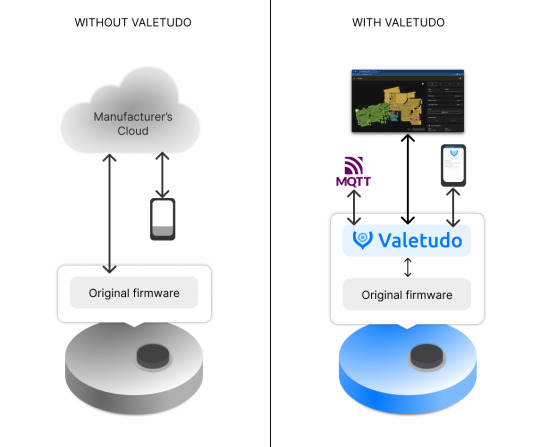
16 notes
·
View notes
Text
after god art style study --part 1
first off disclaimer I don't really know if there's a supposed professional/appropriate method of studying artist's art styles so please don't expect this to be polished or like a tutorial in any way this is just me spending a lot of time admiring eno sumi's art
thoughts overall
eno's art has a pretty semi-realism leaning anime art style. it's not conventionally cute, the level of detail is what you'd see in a seinen manga. thumbs up it works out just right
because this is manga with what looks like a monthly to biweekly release schedule yeah I too would want to be paid $$$$ as my full time job if I were drawing with that crunch deadline so shortcuts and corner cutting are taken to make the job easier. I particularly want to study some of the shortcuts in addition to the way she stylizes certain things in her art style.
I used to have a very cutesy/baby-faced anime art style and had really wanted to move more away from that to something more mature-looking. studying how an artist stylizes something is a cool way to figure out how you want to depict something in your style too. obviously still do take life studies and all... there is nuance between understanding how an artist builds on top of fundamentals versus copying plainly what is depicted. I know how to draw noses but I couldn't figure out or visualize how it'd best look in my artwork.
I dooooo still have to learn how to draw old people like old-old people aaaaaaaaaaaaaaaaaaaaaaaaaaaaaaaaaaaaaaa
clip studio paint and tools -------
I previously identified in an older post eno most likely works with clip studio paint.. eno has posted here about CELSYS which is the company that owns CSP.
more csp stuff:
background black swirls is 黒うず from ベタ部分に使うブラシ
you guys like the default crack brush? me too the triangle shape is very noticable
some of the other cracks in the scene looks like its from 瓦礫を描くブラシセットおまけ付き
lightning brush from lightning brushes
this is a very good water brush set





3d models -------
I personally cannot really discern perfectly if 3d models were ever used for posing the characters- if there was use of 3d character models then thank god they weren't directly traced over bc 3d does not translate to 2d well when it's directly traced over and that type of jarring uncanny proportions is what I'm used to seeing when that happens.
however, sometimes it is kinda noticable when the anatomy looks a little bit wonky or rushed. I don't blame it that much for comic making standards
[tokinaga are you okay you look kinda rough]
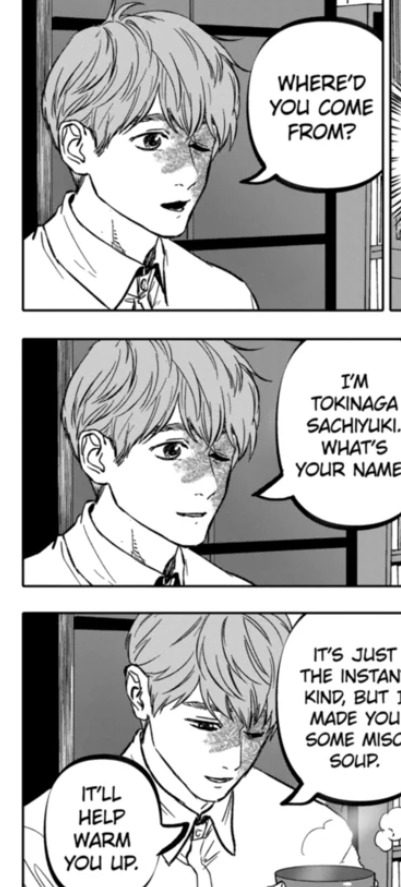
[ch.32 has a bunch of can models]

3d models are most often used for the backgrounds in After God or for smaller, repetitive objects. they're integrated pretty seamlessly in my opinion, but also in my opinion I have to consider my bar is below the ground because I read webtoons time to time and the number of poorly or lazily implemented 3d background assets makes me sad



[tokinagas apartment] [2]
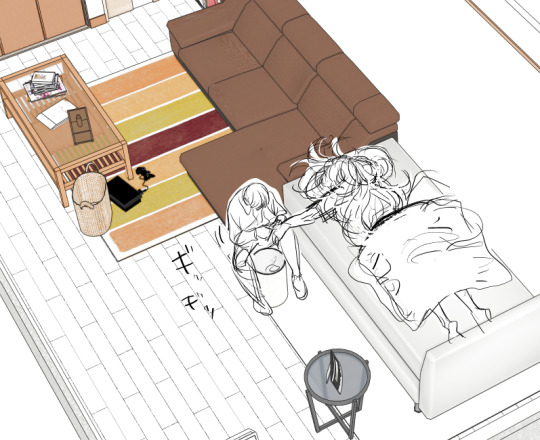
I remember in my blog read through I had google translate catch she mentioned she used home design 3d or something something to make the house models. unfortunately I don't know where the exact mention was (i dont speak or read japanese bummer) so take it with a grain of salt
noses -------
nosesss!!
they are more detailed than the typical "single dot/line" anime nose, I really appreciate that. the variety within the main characters isn't very wide, but I digress. if it's easy to draw then it's easy to draw and it's nice to feel no pressure drawing what you want to draw
the most common nose drawn is a line for the bridge and two lines indicating the nostrils. the two nostril lines may vary in direction depending on if you're viewing the face, differing angles from above or face from below

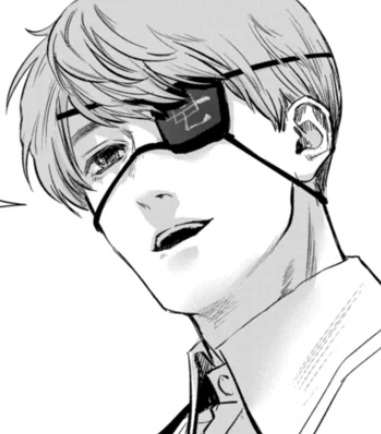
frequently, in addition to that, the tip of the nose is also defined.

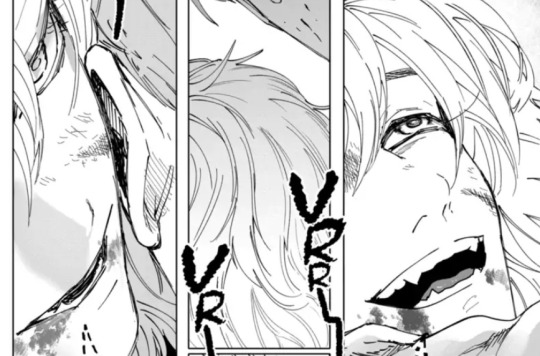

sometimes the bridge is given some additional depth with some hatching instead of a singular line.

sometimes, only the nostrils are drawn. shading may be used to define the nose shape instead of using lineart.


sometimes instead of a line for the nose bridge, a "triangle" shine shape is drawn. usually it shows up on smaller images.


very rarely does it ever end up being drawn as a single line (either for the nose bridge OR the bottom of the nose).

the diversity of noses typically shows up the most on the older aged characters. or the non-japanese characters.
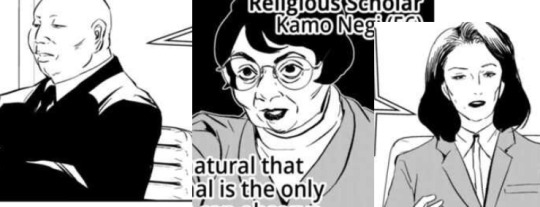


chin-up profiles -------
honestly i don't see really actual bottoms of the chins drawn that often and when I do it's rather rare or simplified




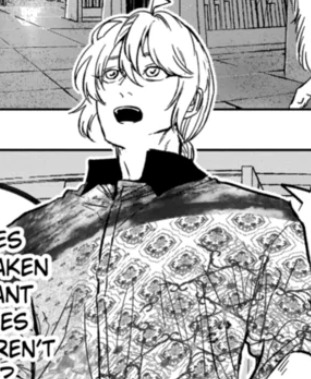
---
cont in part two
10 notes
·
View notes
Text
Interesting Papers for Week 8, 2025
Perception—Action dissociations depend on factors that affect multisensory processing. Bruno, N., & Uccelli, S. (2024). PLOS ONE, 19(11), e0301737.
Audiovisual simultaneity windows reflect temporal sensory uncertainty. Cary, E., Lahdesmaki, I., & Badde, S. (2024). Psychonomic Bulletin & Review, 31(5), 2170–2179.
Integration and competition between space and time in the hippocampus. Chen, S., Cheng, N., Chen, X., & Wang, C. (2024). Neuron, 112(21), 3651-3664.e8.
Reconciling categorization and memory via environmental statistics. Devraj, A., Griffiths, T. L., & Zhang, Q. (2024). Psychonomic Bulletin & Review, 31(5), 2118–2136.
Dendritic, delayed, stochastic CaMKII activation in behavioural time scale plasticity. Jain, A., Nakahata, Y., Pancani, T., Watabe, T., Rusina, P., South, K., Adachi, K., Yan, L., Simorowski, N., Furukawa, H., & Yasuda, R. (2024). Nature, 635(8037), 151–159.
Semi-orthogonal subspaces for value mediate a binding and generalization trade-off. Johnston, W. J., Fine, J. M., Yoo, S. B. M., Ebitz, R. B., & Hayden, B. Y. (2024). Nature Neuroscience, 27(11), 2218–2230.
Dopamine-mediated formation of a memory module in the nucleus accumbens for goal-directed navigation. Jung, K., Krüssel, S., Yoo, S., An, M., Burke, B., Schappaugh, N., Choi, Y., Gu, Z., Blackshaw, S., Costa, R. M., & Kwon, H.-B. (2024). Nature Neuroscience, 27(11), 2178–2192.
Synapses learn to utilize stochastic pre-synaptic release for the prediction of postsynaptic dynamics. Kappel, D., & Tetzlaff, C. (2024). PLOS Computational Biology, 20(11), e1012531.
A normative framework dissociates need and motivation in hypothalamic neurons. Kim, K. S., Lee, Y. H., Yun, J. W., Kim, Y.-B., Song, H. Y., Park, J. S., Jung, S.-H., Sohn, J.-W., Kim, K. W., Kim, H. R., & Choi, H. J. (2024).Science Advances, 10(45).
Cholinergic regulation of dendritic Ca 2+ spikes controls firing mode of hippocampal CA3 pyramidal neurons. Kis, N., Lükő, B., Herédi, J., Magó, Á., Erlinghagen, B., Ahmadi, M., Raus Balind, S., Irás, M., Ujfalussy, B. B., & Makara, J. K. (2024). Proceedings of the National Academy of Sciences, 121(46), e2321501121.
Inability to pursue nonrigid motion produces instability of spatial perception. Koerfer, K., Watson, T., & Lappe, M. (2024). Science Advances, 10(45).
Decomposing dynamical subprocesses for compositional generalization. Luettgau, L., Erdmann, T., Veselic, S., Stachenfeld, K. L., Kurth-Nelson, Z., Moran, R., & Dolan, R. J. (2024). Proceedings of the National Academy of Sciences, 121(46), e2408134121.
Maintaining and updating accurate internal representations of continuous variables with a handful of neurons. Noorman, M., Hulse, B. K., Jayaraman, V., Romani, S., & Hermundstad, A. M. (2024). Nature Neuroscience, 27(11), 2207–2217.
V1 neurons are tuned to perceptual borders in natural scenes. Papale, P., Zuiderbaan, W., Teeuwen, R. R. M., Gilhuis, A., Self, M. W., Roelfsema, P. R., & Dumoulin, S. O. (2024). Proceedings of the National Academy of Sciences, 121(46), e2221623121.
Quantifying resource sharing in working memory. Pougeon, J., Camos, V., Belletier, C., & Barrouillet, P. (2024). Psychonomic Bulletin & Review, 31(5), 2305–2312.
Community-based reconstruction and simulation of a full-scale model of the rat hippocampus CA1 region. Romani, A., Antonietti, A., Bella, D., Budd, J., Giacalone, E., Kurban, K., Sáray, S., Abdellah, M., Arnaudon, A., Boci, E., Colangelo, C., Courcol, J.-D., Delemontex, T., Ecker, A., Falck, J., Favreau, C., Gevaert, M., Hernando, J. B., Herttuainen, J., … Markram, H. (2024). PLOS Biology, 22(11), e3002861.
Brief category learning distorts perceptual space for complex scenes. Son, G., Walther, D. B., & Mack, M. L. (2024). Psychonomic Bulletin & Review, 31(5), 2234–2248.
Human hippocampal and entorhinal neurons encode the temporal structure of experience. Tacikowski, P., Kalender, G., Ciliberti, D., & Fried, I. (2024). Nature, 635(8037), 160–167.
The interhemispheric amygdala-accumbens circuit encodes negative valence in mice. Tian, Z., Song, J., Zhao, X., Zhou, Y., Chen, X., Le, Q., Wang, F., Ma, L., & Liu, X. (2024). Science, 386(6722).
Distinct septo-hippocampal cholinergic projections separately mediate stress-induced emotional and cognitive deficits. Wu, J.-L., Li, Z.-M., Chen, H., Chen, W.-J., Hu, N.-Y., Jin, S.-Y., Li, X.-W., Chen, Y.-H., Yang, J.-M., & Gao, T.-M. (2024). Science Advances, 10(45).
#neuroscience#science#research#brain science#scientific publications#cognitive science#neurobiology#cognition#psychophysics#neurons#neural computation#neural networks#computational neuroscience
6 notes
·
View notes
Note
🌻:]
I have Amazing Digital Circus brainrot. Caine by beloved.
I drew a crappy rendition of my tadc oc, Drea, in ms paint so i could test colors out.

Shes meant to sort of be one of those blanket doll things like this:

but kinda messed up because the headset was placed on her while she was sleeping, causing a few, glitches, in her player model and programming.
For example she sleeps for 50 and then wakes up for seven days before being forced alseep again. I figured it would be semi-easy to integrate her into cannon that way (and reflect my own sleeping and fatigue issues for angst purposes lol)
14 notes
·
View notes
Text




HIGH STANDARD MODEL TEN
12 GAUGE; 18.25'' barrel, Designed for use by Police as an entry weapon. High Standard manufactured c.1960's, Series B, using the semi-automatic M1200 shotgun. 2 3/4" chamber, 4 round magazine capacity. Carry handle with integral fixed rear sight. Folding front sight. Rotating buttplateh these shotguns didn't have the greatest reputation for reliability.
15 notes
·
View notes
Text

Alright, allow me to explain what's going on here, as this is something I've never brought up before (aside from one time back in January).
This morning (April 4, 2025) marks the 20th anniversary of Great 5 Productions' online preschool block for Cartoon Network known as "Cartoon Preschool". The block would run from 2005, all the way to the beginning of 2021 (New Year's Day to be exact).
Not counting programs from the 90s such as Big Bag and Small World, this marks the first time that CN has delved into the world of preschool programming (launching a few months before Tickle U).
The block was created with 2 rules in mind:
Always deliver programming that parents and teachers not only trust, but can utilize to help enhance and improve the skills of children both at home and in school.
NEVER abbreviate the block's name, no matter what!
In hindsight, that's probably why my logo ideas were always rejected.
With that out of the way, let's talk about some history involving the block.

The block would begin as an interactive slideshow/playlist with lessons and topics for preschool teachers to utilize in a classroom setting, featuring episodes of 8 different shows.
These slideshows would be added to the Cartoon Preschool website every weekday at 6am, just in time for teachers in school to begin setting up their lectures at 8am. Here were the shows in question...
6:00 AM - The Learning Show: While the main title was a bit basic, the idea was simple and easy to pull off. The host, named Edlen (at least I think that's his name, I can't remember), would guide the audience through a different topic each episode, whether it be arts and crafts or learning simple words from another language (pretty much any topic safe for preschoolers could be the subject of an episode). Oftentimes, at least early on, the topic of the episode would continue to apply to the rest of the shows for that particular day. While the show would end in 2016, it would still start off nearly every broadcast of Cartoon Preschool's run.
TL;DR - Guy with weird name talks about a topic.
6:30 AM - Hi-5: It should be noted that much of Cartoon Preschool's programming, especially by the late 2010's, would be acquired from other networks (due to partnering with many different companies and channels). Case in point, the Australian TV series known as Hi-5. To quote Wikipedia, "The series is designed for a pre-school audience, featuring five performers who educate and entertain through play, movement and music, which is an integral part of the series. The segments of the show are based on an educational model." While the block would start out including the full 30-minute episodes, these would be shortened to about 22-minutes by 2010 (around the time that the block began broadcasting in the form of livestreams) in order to save time.
TL;DR - 5 Australian people encourage movement through music.
7:00 AM - PBS Kids: The Adventures of Dash & Dot: Now THIS one definitely screams "we were only allowed to make this because we partnered with the copyright holders". While this show would mainly focus on the titular brother and sister characters, there would also be instances of other characters (most of them can be seen in this piece of fanart by user LuxoVeggieDude9302) getting the spotlight at times. While their names in the 2020 semi-reboot would originate from cast members from the PBS series ZOOM (the same names that the fandom has coined for them), the original series would give them their own names. This is also the first series we'll be talking about that's interactive, with the characters engaging the audience in order to help solve a problem that a character is having. While the series would end in 2012, it would eventually get a spin-off series in 2016 (based around the online game "Kart Kingdom"), as well as the semi-reboot in 2020 that I mentioned earlier (retaining a similar art style, but with stories and topics for a modern audience). By 2017, the block would often rotate between reruns of the original series and its continuations (i.e. an episode of the original series would air one day, and then an episode of Kart Kingdom might air the next).
TL;DR - Interactive adventures with green characters.
7:30 AM - Childhood Cartoons: Yet another one with a strange name, but also another one with interactive elements. The show is set in "CC Studios", a radio station with 2 hosts guiding the audience through music. Their names are Jean, pronounced "John" (a guy with dots for eyes, but also a silly haircut), and Luc, pronounced "Luke" (a guy with squares and straight lines for a body), a duo of friends who not only play music, but also show segments (2 in nearly each episode) of kids going through different problems that the target audience may go through as well. The segments are almost always shown from the POV of the child figuring out the problem, and the 2 shown in each episode would always focus on a singular topic or idea. Instances of music numbers would also be included via the 2 radio guys playing them from their studio. It should be noted that another significant aspect of the show is the dynamic of Jean and Luc, which would be expanded upon in later episodes (most notably the show's Christmas special, which I might talk about at a later date). While the show would end in 2014, the series would continue to air on the block for the rest of its run.
TL;DR - 2 guys host a radio show, but only sometimes play music.
8:00 AM - The Wiggles: Yet another acquired program, and also yet another one from Australia. I mean, do I even need to explain who the Wiggles are? They're probably one of the most well known children's bands out there. While the block would begin airing the band's TV shows (introducing the later ones when they came out), they would eventually start airing the group's made-for-video specials (usually saving them for special occasions).
TL;DR - Any online source like Wikipedia or the official website will have a better explanation of who the Wiggles are than I could ever come up with.
8:30 AM - The Reaching Show: This one is often considered the black sheep of the original Cartoon Preschool lineup. That name is definitely warranted, because this show just sucks. It's a show about... reaching for things... wow, I'm thrilled. The block tried to justify it's existence by claiming it was useful for stuff like stretching exercises, but no one was convinced. It was just a show about reaching for things, and absolutely no one cared about it. By the beginning of 2007, the higher ups at Great 5 productions were fully aware of the poor reception and pulled the show from its lineup in late May. After this point, the show would never be mentioned by the network ever again.
TL;DR - Dumb show that no one cared about was cancelled and forgotten.
9:00 AM - Emmy + Dave: Just like PBS Kids, this show featured a brother and sister, and had 2 11-minute segments in each episode. Unlike PBS Kids, this show had limited dialogue, aside from a narrator and the siblings' parents. The show is about the 2 titular siblings (who later became the hosts of the block as they got older) learning about the outside world in different ways (whether it be their backyard, the school playground, the beach, etc.), while also learning morals and understanding how to be a good person. Despite overall positive reception, the series would be pulled in 2013. Part of this is because of the siblings teaching the same lessons as hosts for Cartoon Preschool, which left the series mostly irrelevant. However, this is also because the show only lasted 1 season with 13 episodes (26 segments total), so the series was dropped to make way for another show that we'll get to later. That said, the show would still have a webpage on the Cartoon Preschool site for the rest of the block's run (unlike the Reaching Show).
Before we move on, I should note that this show is an early instance of a show being filmed in the Cartoon World, as shown by the inclusion of a talking little yellow octopus named Otto, who the siblings befriend after he's found washed up on the beach all alone. The octopus would also make appearances during Emmy and Dave's hosting segments, suggesting that he has an extended lifespan (just like other cartoon characters).
TL;DR - Hosts of the Cartoon Preschool block encourage kids to touch grass.
9:30 AM - Traveling Adventures: Lastly, we have this show. Once again, this one is a bit weird. It's about a boy named Markus who, one day while walking home from school, comes across a mysterious girl who can't seem to remember where she's from or where her parents are. However, she does seem to have a love for Geography, and that she isn't malicious at all. After bringing her home to his mother (who is skeptical, but willing to trust her), she reveals that her name is Gianna (Gia for short), and that perhaps traveling the world could help her rediscover her parents. She reveals that she has a necklace that the person wearing it can use to teleport to other locations (if they want to go back, they simply take it off). Since Markus isn't a fan of his school's Geography lectures, he figures that this could make it more interesting (and fun to learn about).
But who and where are Gianna's parents? Well, near the end of season 1, Gianna accidentally finds out that she can shape-shift into different animals (don't worry, there was plenty of foreshadowing beforehand), giving way for speculation regarding her origins. At the end of the series, it's revealed that her parents are talking elephants living in the African savannah. It's also revealed that Gianna's elephant (which had made a number of appearances up to that point) from was actually her main form this whole time, which had been shown by her personality traits matching that of an elephant (sometimes bold, sometimes shy, curious or afraid, etc.).
While the show was well-received, lasting 2 seasons, it would later be pulled from the lineup in 2014 (being cancelled in late 2012). The reason being that despite the positive reception, the show was clearly meant for a slightly older audience than the other shows on Cartoon Preschool. Despite this, reruns of the show would later return for special occasions.
TL;DR - Boy and elephant travel the world.
That's it for the shows that were on the block at the start. Now let's move onto the later introductions. For the sake of time, we'll just be looking at the 3 original shows that were introduced (I'll save the acquired stuff for when I create a page for the block on the CN Fanon Wiki)...
8:30 AM - A Kid's Life: Introduced on May 26, 2008, the series A Kid's Life would air in the Reaching Show's old time slot (pushing Emmy + Dave and Traveling Adventures back to their old time slots, after they were moved back half-an-hour in 2007). The series followed a kid named Jack and his father Charles. The episodes would be about Charles guiding Jack through everyday life. While the show would mainly be from Jack's POV, certain episodes would follow Charles as he tried not only to prevent talking down to his son, but to also show Jack that he cares about him. While the show's reception was somewhat mixed at first, it soon became a worthy member of the block's lineup (especially compared to the Reaching Show).
TL;DR - Father teaches son about everyday life.
Moving onto 2010, Cartoon Preschool would make 2 changes on May 29 of that year. The first was changing its logo (the same day that CN introduced its Check It rebrand)...

The second change was introducing a proper broadcasting format, in the form of livestreams on the block's website (which then began also streaming on YouTube a year later in 2011), with the block now properly running from 6am - 10am. While there would be a few technical difficulties at first, things did eventually get sorted out.
This leads us onto our next show...
9:00 AM - Big and Little: Introduced on May 27, 2013 (the same day that Cartoon Preschool started airing commercial breaks), Big and Little would air in Emmy + Dave's old time slot. The show centers around 2 aliens from outer space, a giant named Big One (who is rarely shown from the waist up) and a young creature with a bean-shaped body and no arms or legs named Little One (who uses telekinesis to carry things around). The 2 creatures live together and spend episodes learning that "there are some things that only big guys can do, as well as things that only little guys can do."
It should be noted that this is actually a joint production with the British company BBC, as shown by the instances where the duo get in contact with the British duo Big & Small in order for them to solve a problem that they're having.
TL;DR - Giant creature and small creature with no arms or legs do tasks that fit their respective sizes.
Lastly, we have...
9:30 AM - Hello World: Introduced on March 24, 2014, Hello World would air in Traveling Adventures' old time slot. We have 2 siblings (an older sister named Jackie, and a younger brother named Edward), who discover a magic wand in their new bedroom that they can use to travel the world. It's somewhat like Magic Tree House in a way, mainly since the one who created the wand is an enchantress (named Madison, or M for short). While she seems kind and trustworthy in the first few seasons, she's soon revealed to actually be greedy, eager to steal the siblings' family's money for her own gain. After she is dealt with in the special "M's End", her much nicer husband, Lionel (or L for short), takes her place.
I actually brought up this show once before. Back in January, I talked about CN Fridays' January 13, 2017 show, in which I mentioned that the M's End special had premiered during this show.
Despite the series ending in 2019, reruns would continue for the rest of the block's run.
TL;DR - 2 Siblings travel the world using a magic device.
Hello World would be the last original series that Cartoon Preschool released. Everything that was introduced afterwards would be acquired from (or based around something from) other networks.
As for the block's reception, while it was well received for its educational aspects (especially compared to Tickle U), it was also panned by some for having live action shows attached to a channel meant for cartoons (i.e. Hi-5 and The Wiggles).
That's about everything I have time to talk about, I'll be saving the rest for-
*ahem*
*sigh* Fine, I guess we have time to talk about one more show.
On September 2016, The Wiggles was temporarily removed from the lineup. The group's then-upcoming 9th TV series (Wiggle Wiggle Wiggle!) was still in production, and the show wouldn't return until it was ready to air. But that wasn't the only reason the show was briefly dropped...
8:00 AM - Blue's Clues: In honor of the show's 20th anniversary, Cartoon Preschool began airing reruns of Nick Jr.'s Blue's Clues in its place. To quote Wikipedia, "The show follows an animated blue-spotted dog named Blue as she leaves a trail of clues/paw prints for the host [Steve (and later Joe)] and the viewers to figure out her plans for the day."
The show, airing in mostly chronological order (aka production order), would run from September 5, 2016 - October 6, 2017.
Similar to airings of the show during the late 90's and early 2000's, Cartoon Preschool would air one episode of Blue's Clues 5 times a week. When asked why, it was stated that kids learn best through repetition.
Despite being removed in 2017, the show would return on several occasions starting in late 2019, and would once again become a mainstay the following Spring.
TL;DR - Look up Blue's Clues' Wikipedia page. The show was acquired by Cartoon Preschool and aired in place of The Wiggles, at least until the band's newest series was finished.
Alright, once again, I'll be saving the rest of Cartoon Preschool's history for when I get around to creating a page about the block on the CN Fanon wiki.
Please let me know if I made any grammatical errors on this post, as I'm too tired to check for myself.
#anniversary#cartoon preschool#cartoonpreschool#cartoon network#cn#cartoonnetwork#the learning show#hi-5#hi 5#pbs kids#childhood cartoons#the wiggles#the reaching show#emmy + dave#traveling adventures#a kid's life#big and little#hello world#blue's clues#blues clues
3 notes
·
View notes
Note
The "core" term is part of World Systems Theory. China and Russia are considered "semi-peripheral" to describe their integration into and roles in the world economy. It's a useful theory for e.g. modelling more complex exploitative relationships between countries, such as labor flows in e.g. Singapore<Malaysia<Indonesia where each country is taking advantage of relatively cheap immigrant labor from the next one in line.
The "imperial" part is true but usually only added by communists & anarchists.
it seems awkward to base this on trade as in the year 2000 with core status providing "a market for exports" because of course the US runs a persistent trade deficit while "semi-periphery" (!) nations like China and Korea run persistent trade surpluses.
seems easier to just note whether countries are economically strong and have strong institutions, two factors that usually go together anyway.
18 notes
·
View notes
Text
Tagged a bit ago by @prometheus-ghost and @depressedcorvid ^^
Favorite movie: Ahhh... Young Frankenstein is my default answer but there are a lot of films I love.
Favorite TV show: 1899!! 1899!! AHHHHH
Favorite musical artist: The perfect blend of beauty and horror, of traditional Japanese music and metal, of seriousness and batshit goofy insanity, of poetry and guttural screams... absolutely lovely people when I met them, values I agree with, taught me how to be humble but always strive to be better, and damn they put on a hell of a show that feels like being swept away... Like, I thought I knew what a good performance looked like before I saw them, but seeing them live really felt like I was drowning. In fun. The one, the only... Kiryu.
Favorite color: Black is number one, but I also really like wine red.
Favorite season: Autumn, by a long shot.
Favorite book: Big fan of It and 11/22/63, both by Stephen King (what is it with me liking things that are just numbers). It was something I expected to like, 11/22/63 took me by surprise with how much I couldn't put it down because I had no interest in the Kennedy assassination before I read it.
Do you have any funko pops? A couple of years ago, my brother got me a Thor funko pop for my birthday because all he knew about me was I liked Thor Ragnarok.
Do you play any instruments? Violin, on a semi-professional level. I can play enough piano to trick people who can't play piano into thinking I can, and I can play like five songs on guitar but the head broke so I haven't practiced in a while.
Do you have any pets? My little calico kitty-cat, Musubi! AKA Musubaby, AKA Musu-bean, AKA Mususu.
Do you read or write fanfiction? Ahhh I used to read more when I was more in my Good Omens phase. I think the one that blew my mind was called "Demonology and the Tri-Phasic Model of Trauma: an Integrative Approach." I began to write one to sort out my feelings about my best friend disappearing off the face of the planet, but I gave up because it was making me more sad than anything else.
What songs have you had on repeat lately? Today, "Utsutsu, Bouga wo Kurau/現、忘我を喰らう" and "Camui/カムイ" by Dir En Grey, "Chihiro" by Billie Eilish, and "Paranoid Bulldozer Italiano" by Igorrr.
If you'd like, I'll tag @cozynightsky @relto @yuuana
3 notes
·
View notes
Text
Transiting Sun enters Capricorn
Friday, December 22, 2023 - Saturday, January 20, 2024
Capricorn the Sea Goat*:
Earth (material - practical, grounded, sensual, reliable, stable, cautious)
Yin (gravity - ingoing, receptive, intuitive, collecting)
Cardinal (initiating action - generating, acting, directing)
Transpersonal (universal - focused on ideals and abstractions)
“I utilize”
Ruler - Saturn; exalted - Mars
Color: deep forest greens and pine greens
(* Gleaned almost completely from the book Astrology for Yourself by Bloch and George; the color is my own theory/belief.)
I always feel a definite “jolt” in the vibe, as we transition from raucous Sagittarian “deck the halls,” to contemplative Capricornian “silent night, holy night.”
And the whole “New Year’s resolution” tradition is a good way to feel the general Capricorn intention: we’re taking a longer term view, trying to determine the best path going forward to promise the most success.
The Sun’s transit through Capricorn, this time, is bracketed by some significant conjunctions: we begin with Sun-Mercury, and end with Sun-Pluto.
Friday, December 22 - Sun/Capricorn conjunct Mercury Rx/Capricorn, 0°39’. A systems upgrade for our frame of mind - we take a more serious, disciplined approach. How can we be cannier about life?
Sunday, December 24 - Sun/Capricorn sextile Saturn/Pisces, 2°37’. Oh yes, we’re taking Capricorn seriously, all right - exploring dimensions we can’t find in a cursory, superficial glance.
Tuesday, December 26 - Sun/Capricorn (4°30’) sesquisquare Uranus Rx/Taurus (19°30’). A little post-holiday frustration? We see where we want to be, and we can’t quite get there . . . yet.
Wednesday, December 27 - Sun/Capricorn trine Jupiter Rx/Taurus, 5°36’. Feel better now? That goal isn’t as far away as it seems.
Saturday, January 6 - Sun/Capricorn square Chiron/Aries, 15°29’. Watch out for hurt feelings when people don’t acknowledge one another. We are stronger together, and we’re all equals.
Then a very intense few days between Tuesday, January 9 - Friday, January 12:
Sun/Capricorn semi-sextile Ceres/Sagittarius, 19°00’
Sun/Capricorn (19°04’) semi-square Saturn/Pisces (4°04’)
Sun/Capricorm trine Uranus Rx/Taurus, 19°13’
Sun/Capricorn square North Node/Aries and South Node/Libra, 20°21’
New Moon, 20°44’ Capricorn
Sun/Capricorn trine Juno/Virgo, 21°52’
Sun/Capricorn sextile Pallas Athene/Scorpio, 21°53’
The main thing is the New Moon, with all the other aspects valid for it. We’re very interested in making practical innovations, more on a scale of benefiting our everyday lives and relationships. Be wary of “my way or the highway” attitudes, of Eeyore-like negative attitudes, and especially of “going along to get along.”
Sunday, January 14:
Sun/Capricorn inconjunct Vesta Rx/Gemini, 24°00’
Sun/Capricorn square Eris/Aries, 24°09’
Ego getting in the way, and a lack (or failure) of personal integration. Guard against anger undoing our plans and hard work.
Monday, January 15 - Sun/Capricorn sextile Neptune/Pisces, 25°21’. In the US, this is Martin Luther King Jr. day. There’s an exemplary Capricorn role model for us. Read his final speech for some pure Capricorn. (And read his Riverside Church speech “Beyond Vietnam” for more Cap insight.)
Saturday, January 20 - Sun/Capricorn conjunct Pluto/Capricorn, 29°59’. This is the very last Sun-Pluto conjunction in Capricorn for the next 240-ish years. Think about everything we’ve gone through between 2008 and now - what went wrong, what went right - and how has all that changed our perception of Capricorn? The Sun enters Aquarius a mere 21 minutes after this conjunction matures, followed by Pluto about 11 hours aftwrward.
15 notes
·
View notes
Photo

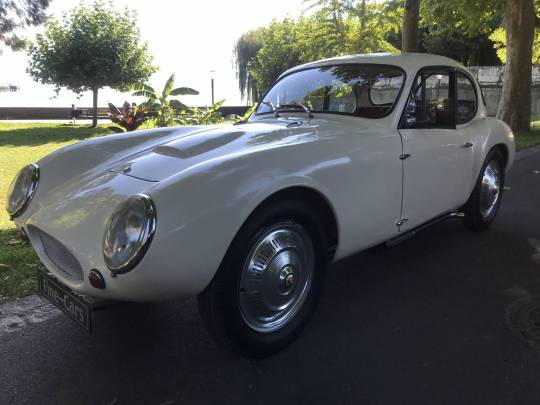

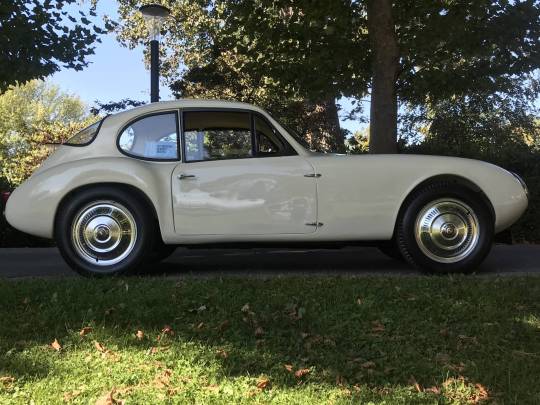
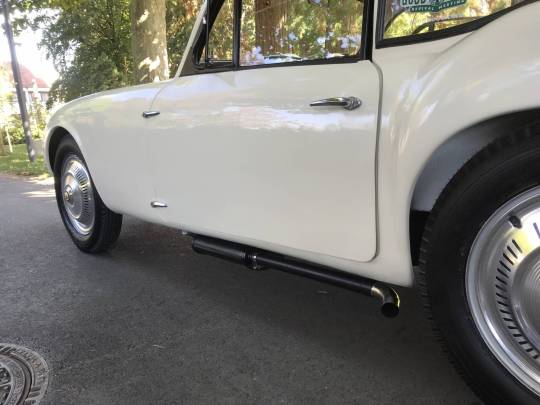


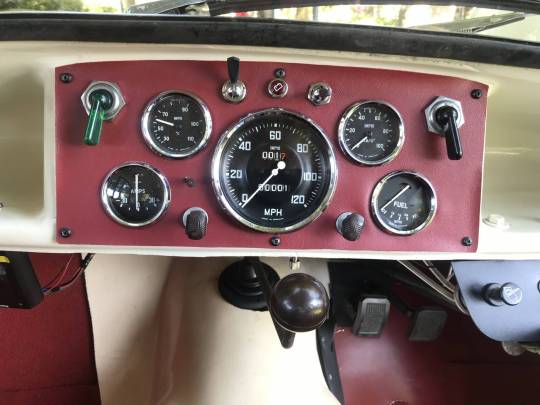


Rochdale GT
Rochdale Motor Panels & Engineering Ltd started in 1948 as panel beaters before turning to the manufacture of aluminium bodies for competition cars and then glassfibre bodyshells for the specials-building industry. By 1954 Rochdale was offering its MkIV glassfibre body, intended for the pre-war Austin Seven chassis. With the latter's availability declining, Rochdale offered the more extensive 'ST' kit for the Ford Ten/Popular chassis. The 'ST' was an open design lacking torsional stiffness, and after a few had been made it was superseded by the beautifully proportioned Rochdale 'GT', which according to its maker was 'not a shell to adapt to your Ford but a complete body designed specifically to fit'. Intended for the Ford 8/10hp chassis, the 'GT' became available from 1960 with Rochdale's own frame. One of the most elegant small sports cars of its day, the 'GT' would go on to be Rochdale's best-selling model, with an estimated 1,350-or-so made, of which it is believed fewer than 80 survive. Rochdale abandoned the kit-car side of its business in the early 1970s.
Featuring a lightened semi-spaceframe chassis, built in period using Ford Popular side members, the car is powered by a full-race specification 1½-litre Coventry-Climax FWB engine producing 140bhp. Other specification highlights include an integral roll cage; straight-cut close-ratio gearbox; double-wishbone front suspension; Lotus 11 front discs and magnesium callipers; Austin Metropolitan rear axle with limited-slip differential and five-link location; competition brake linings at the rear; 15" wire wheels shod with Dunlop racing tyres; long-range 'Le Mans' fuel tank; Speedwell gauges; Halda Speedpilot; and Heuer Monte Carlo stopwatch.
42 notes
·
View notes
Text
Big Data and AI: The Perfect Partnership for Future Innovations
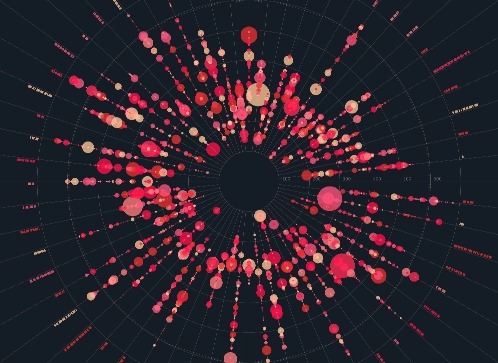
Innovation allows organizations to excel at differentiation, boosting competitive advantages. Amid the growth of industry-disrupting technologies, big data analytics and artificial intelligence (AI) professionals want to support brands seeking bold design, delivery, and functionality ideas. This post discusses the importance of big data and AI, explaining why they matter to future innovations and business development.
Understanding Big Data and AI
Big data is a vast data volume, and you will find mixed data structures because of continuous data collection involving multimedia data objects. A data object or asset can be a document, an audio track, a video clip, a photo, or identical objects with special file formats. Since big data services focus on sorting and exploring data objects’ attributes at an unprecedented scale, integrating AI tools is essential.
Artificial intelligence helps computers simulate human-like thinking and idea synthesis capabilities. Most AI ecosystems leverage advanced statistical methods and machine learning models. Their developers train the AI tools to develop and document high-quality insights by processing unstructured and semi-structured data objects.
As a result, the scope of big data broadens if you add AI integrations that can determine data context. Businesses can generate new ideas instead of recombining recorded data or automatically filter data via AI-assisted quality assurances.
Why Are Big Data and AI Perfect for Future Innovations?
1| They Accelerate Scientific Studies
Material sciences, green technology projects, and rare disorder research projects have provided humans with exceptional lifestyle improvements. However, as markets mature, commoditization becomes inevitable.
At the same time, new, untested ideas can fail, attracting regulators’ dismay, disrespecting consumers’ beliefs, or hurting the environment. Additionally, bold ideas must not alienate consumers due to inherent complexity. Therefore, private sector stakeholders must employ scientific methods to identify feasible, sustainable, and consumer-friendly product ideas for brand differentiation.
AI-powered platforms and business analytics solutions help global corporations immediately acquire, filter, and document data assets for independent research projects. For instance, a pharmaceutical firm can use them during clinical drug formulations and trials, while a car manufacturer might discover efficient production tactics using AI and big data.
2| Brands Can Objectively Evaluate Forward-Thinking Business Ideas
Some business ideas that a few people thought were laughable or unrealistic a few decades ago have forced many brands and professionals to abandon conventional strategies. Consider how streaming platforms’ founders affected theatrical film releases. They have reduced the importance of box office revenues while increasing independent artists’ discoverability.
Likewise, exploring real estate investment opportunities on a tiny mobile or ordering clothes online were bizarre practices, according to many non-believers. They also predicted socializing through virtual reality (VR) avatars inside a computer-generated three-dimensional space would attract only the tech-savvy young adults.
Today, customers and investors who underestimated those innovations prefer religiously studying how disrupting startups perform. Brands care less about losing money than missing an opportunity to be a first mover for a niche consumer base. Similarly, rejecting an idea without testing it at least a few times has become a taboo.
Nobody can be 100% sure which innovation will gain global momentum, but AI and big data might provide relevant hints. These technologies are best for conducting unlimited scenario analyses and testing ideas likely to satisfy tomorrow’s customer expectations.
3| AI-Assisted Insight Explorations Gamifies Idea Synthesis
Combining a few ideas is easy but finding meaningful and profitable ideas by sorting the best ones is daunting. Innovative individuals must embrace AI recommendations to reduce time spent on brainstorming, product repurposing, and multidisciplinary collaborations. Furthermore, they can challenge themselves to find ideas better than an AI tool.
Gamification of brainstorming will facilitate a healthy pursuit of novel product features, marketing strategies, and customer journey personalization. Additionally, incentivizing employees to leverage AI and big data to experiment with designing methods provides unique insights for future innovations.
4| You Can Optimize Supply Chain Components with Big Data and AI Programs
AI can capture extensive data on supply chains and offer suggestions on alternative supplier relations. Therefore, businesses will revise supply and delivery planning to overcome the flaws in current practices.
For instance, Gartner awarded Beijing’s JD.com the Technology Innovation Award in 2024 because they combined statistical forecasting. The awardee has developed an explainable artificial intelligence to enhance its supply chain. Other finalists in this award category were Google, Cisco, MTN Group, and Allina Health.
5| Academia Can Embrace Adaptive Learning and Psychological Well-Being
Communication barriers and trying to force all learners to follow the standard course material based on a fixed schedule have undermined educational institutions’ goals worldwide. Understandably, expecting teachers to customize courses and multimedia assets for each student is impractical and humanly infeasible.
As a result, investors, policymakers, parents, and student bodies seek outcome-oriented educational innovations powered by AI and big data for a learner-friendly, inclusive future. For instance, some edtech providers use AI computer-aided learning and teaching ecosystems leveraging videoconferencing, curriculum personalization, and psycho-cognitive support.
Adaptive learning applications build student profiles and segments like marketers’ consumer categorizations. Their AI integrations can determine the ideal pace for teaching, whether a student exhibits learning disabilities, and whether a college or school has adequate resources.
Challenges in Promoting Innovations Based on Big Data and AI Use Cases
Encouraging stakeholders to acknowledge the need for big data and AI might be challenging. After all, uninformed stakeholders are likely to distrust tech-enabled lifestyle changes. Therefore, increasing AI awareness and educating everyone on data ethics are essential.
In some regions, the IT or network infrastructure necessary for big data is unavailable or prone to stability flaws. This issue requires more investments and talented data specialists to leverage AI tools or conduct predictive analyses.
Today’s legal frameworks lack provisions for regulating AI, big data, and scenario analytics. So, brands are unsure whether expanding data scope will get public administrators’ approvals. Lawmakers must find a balanced approach to enable AI-powered big data innovations without neglecting consumer rights or “privacy by design” principles.
Conclusion
The future of enterprise, institutional, and policy innovations lies in responsible technology implementations. Despite the obstacles, AI enthusiasts are optimistic that more stakeholders will admire the potential of new, disruptive technologies.
Remember, gamifying how your team finds new ideas or predicting the actual potential of a business model necessitates AI’s predictive insights. At the same time, big data will offer broader perspectives on global supply chains and how to optimize a company’s policies.
Lastly, academic improvements and scientific research are integral to developing sustainable products, accomplishing educational objectives, and responding to global crises. As a result, the informed stakeholders agree that AI and big data are perfect for shaping future innovations.
2 notes
·
View notes
Text
There is no longer any hope of Fox Spirit Mtchmaker Donghua…
They have ruined the most important arc in the Manhua so far…
-They have deleted a lot of important plot, scenes and for characters development
-The additions of some really disgusting scenes that DOESE NOT EXIST IN THE ORIGINAL MANHUA that indicate they intend to ship some characters together that HAVE ALREADY OFFICIAL PARTNER!!!!!!!!!!!!!
-They have ruined Little Yaya character and made her look like a spoiled child throwing tantrums and that semi-revealing scene that focused on her chest with the bandage after she got smaller IS NON-EXISTENT IN THE ORIGINAL MANHUA!!!!!!!!!!!!! BAI YUECHU DID NOT BLUSH WHEN SEEING LITTLE YAYA LOOK LIKE THAT!!!!!!!!!!!!! BAI YUECHU ONLY BLUSHS FOR TUSHAN SUSU!!!!!!!!!!!!! DONGFANG YUECHU NEVER CARRIED LITTLE YAYA!!!!!!!!!!!!! TUSHAN YAYA WOULD NEVER LET THAT HAPPEN IN THE FIRST PLACE!!!!!!!!!!!!! DINGFANG YUECHU ONLY LOVES TUSHAN HONGHONG ROMANTICALLY AND NEVER ANYONE ELSE AND VICE VERSA!!!!!!!!!!!!!
-They have literally DELETED A WHOLE NEW CHARACTER!!!!!!!!!!!!!
-All the characters highlights moments were either deleted or destroyed
-As usual, Wang Fugui getting his own highlights moments and important scenes for the shaping of his character deleted and made him look like a joke character (something he is suffering from the old studio too)
-THEY HAVE RUINED AND DESTROYED THE MINI DONGFANG QINLAN FAMILY ARC AND DELETED IMPORTANT SCENES AND HIGHLIGHTS MOMENTS AND OVERALL THEY HAVE RUIEND THE MOST ANTICIPATED THE MOST EMOTIONAL SCENE OF THE DONGFANG FAMILY!!!!!!!!!!!!
-The movements of the characters are so stiff and not smooth at all
-The art style of the Donghua is getting worse and worse
-The Characteristics and the style of the characters clothing and colors does not match the original Manhua
-They seem to not know how to draw and keep ALL HONGHONG'S & SUSU'S BELLS ON HER CLOTHES AND HAIR TIE!!!!!!!!!!!! EVEN THE HAIR STYLE AND THE LENGTH OF HER HAIR IS WRONG!!!!!!!!!!!!!
-THE POSITION OF THE FOX EARS OF THE THREE SISTERS OF TUSHAN ARE SO WRONG!!!!!!!!!!!!!
-Some of the episodes the voice does not match the lips movements of the characters
-3D models of the characters that are not integrated well with the environment and the backgrounds of the animation which by the way is also extremely terrible
-The entire animation looks like made by AI
-The animation overall is extremely terrible and is THE WORST ANIMATION ADAPTATION I HAVE EVER SEEN!!!!!!!!!!!!!
-THE OFFICIAL ANIMATION ACCOUNT OF FOX SPIRIT MATCHMAKER KEEP BLOCKING AND DELETING CRITICISMS COMMENTS AND BUYING COMMENTS THAT ARE CLERLY SO FAKE AND KEEP MILKING MONEY OF FOX SPIRIT MATCHMAKER FOR WHO KNOWS WHO!!!!!!!!!!!!!
-THERE IS SO MUCH TO RANT FOR BUT WILL NOT BE ENOUGH FOR ONE POST!!!!!!!!!!!!
And after all that you are telling me that they will also make the second half of the arc that is mainly talking about Tushan Honghong?!?!?!?!?!?!?!?!?!?!?!?!?!
Yep, the animation of Fox Spirit Matchmaker is ruined for good (unless they change to a way better respectable animation studio)
#狐妖小红娘#huyao xiao hongniang#fox spirit matchmaker#FSMM#FSMM Manhua#Manhua#FSMM Donghua#Donghua#Rant Post#Good luck to the original author Tuo Xiaoxin for his next work!!!!!!!!!!!!!#Since the Donghua of Fox Spirit Matchmaker is a failure#Just see the Manhua and forget about the terrible adaptions!!!!!!!!!!#READ THE MANHUA#FORGET ABOUT THE DONGHUA#FORGET ABOUT THE LIVE-ACTION CDRAMA
2 notes
·
View notes
Text

Creative people are creative because they evolve and absorb and internalize and synthesize every hour of every day. This isn’t an evolve-or-die moment for creatives. This is a have-or-never-have-again-in-your-lifetime moment for consumers and integrators of our creativity which they’ve borrowed. Tomorrow’s human creativity won’t go away. It will just go out of easy or willing reach.
It’s done this before. Often.
Footnotes:
“Enshittification” doesn’t describe a decline in perceived quality. (Generative content will get past its nineteen-finger era.) It describes the decline in participant-joy of an entire marketplace, as the logical outcome of a prevailing business model:
1) Get non/semi-creatives hooked on generative algorithms.
2) Create a supply and demand apocalypse that pushes real creative workers out of the mass market (I won’t be able to let people be able to afford me, because they’ll push me into a price-war with generative algorithms).
3) With almost nothing but generative algorithms left within reach of the mass market and the corporate market, the handful of suppliers can push up the subscription prices to the absolute limit of what the market will bear, because those markets will be trapped with no one else to use.
We’ve seen it in food. We’ve seen it in clothes. We’ve seen it in housing. We’ve seen it in entertainment. Good isn’t gone. Good is just out of most people’s reach without difficult choices full of which, whether and why.
Like good food, well-made clothes, and great architecture, art and creativity will survive, but it will spend significant time out of affordable reach of the mass market, and far out of consistent or willing reach of the corporate market.
(End of footnotes.)
#creativity#art#inflection point#we’re not obligated to be as short-sighted as they’re choosing to be or to become as ignorant as they’re pretending to be
2 notes
·
View notes